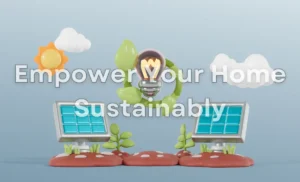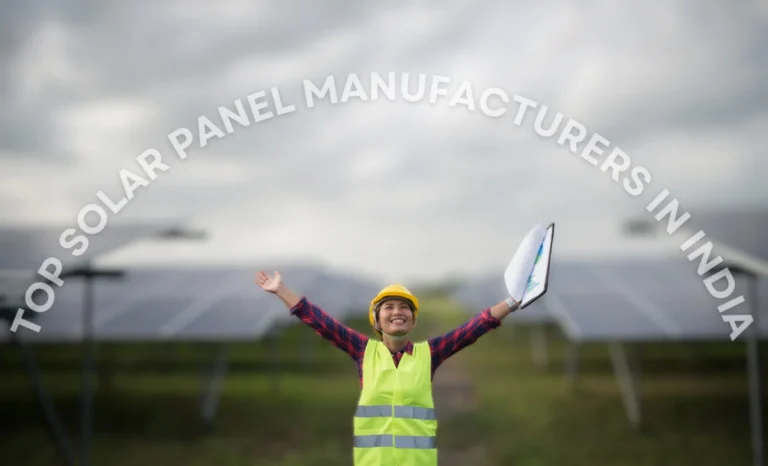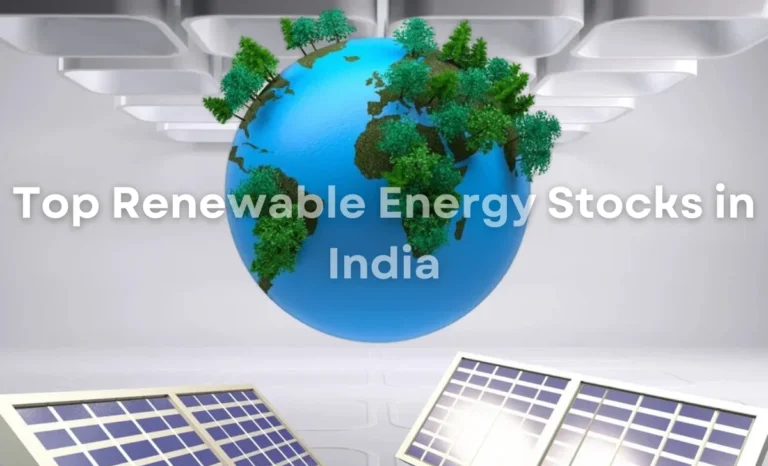Are you ready to transform your home into a sustainable powerhouse? As of January 2025, homeowners across the United States face a pivotal moment in energy choices, with an unprecedented array of renewable energy options at their fingertips. With electricity costs soaring and climate change concerns escalating, transitioning to renewable energy is not just an environmentally responsible decision; it’s a financially savvy investment that can significantly reduce monthly bills
.Did you know that the average American household can save over $1,000 annually by switching to renewable energy sources? This article explores the latest advancements in solar technology, the potential of wind energy, and the benefits of geothermal heating. Each option comes with its unique advantages and challenges, making it essential for homeowners to understand their choices.
Join us as we navigate the comprehensive landscape of renewable energy solutions available in 2025. We’ll cover installation processes, financial considerations, environmental impacts, and the technological innovations shaping the future of residential energy. Whether you’re a first-time homeowner or looking to upgrade your current system, this guide will empower you to make informed decisions in the exciting world of renewable energy.
In this article
Overview of Residential Renewable Energy Options

As of January 2025, U.S. homeowners have a variety of residential renewable energy systems to consider, each offering unique benefits and considerations. Understanding these options can help in selecting the most suitable renewable energy sources at home. For more detailed information on energy-efficient practices, visit our article on energy-saving tips for homeowners.
Solar Energy for Homes:
- Photovoltaic (PV) Panels: PV panels convert sunlight directly into electricity, making them a popular choice for residential renewable energy systems. Advancements in solar technology have improved efficiency and reduced costs, making solar energy for homes more accessible. Additionally, federal tax credits, such as the Residential Clean Energy Credit, offer a 30% tax credit for solar installations, encouraging adoption.
- Solar Water Heating Systems: These systems use solar collectors to heat water, providing an efficient way to reduce reliance on traditional water heaters. They are particularly effective in sunny regions and can significantly lower household energy bills.
Wind Energy:
- Small-Scale Residential Wind Turbines: For homeowners in areas with consistent wind speeds, residential wind turbines can be an effective renewable energy source. However, it’s essential to assess local zoning regulations and wind availability before installation. Incentives for wind energy systems may also be available under current federal programs.
Geothermal Energy:
- Ground-Source Heat Pumps: These systems leverage the constant temperatures underground to provide heating and cooling for homes. While the initial installation cost can be higher, the long-term energy savings and potential incentives make geothermal a viable option for residential renewable energy.
Biomass Energy:
- Biomass Heating Systems: Utilizing organic materials like wood pellets or agricultural waste, biomass systems can serve as a renewable heating source. Recent technological advancements have improved their efficiency and emissions profiles, making them a more environmentally friendly option.
When considering these renewable energy sources at home, it’s crucial to evaluate factors such as geographic location, local climate, and available incentives. Staying informed about U.S. renewable energy incentives in 2025 can further enhance the feasibility and affordability of adopting residential renewable energy systems.
Financial Considerations

When evaluating the adoption of residential renewable energy systems, it’s essential to consider the financial aspects to determine feasibility and return on investment. Key considerations include initial costs, available incentives, and potential savings.
Initial Costs of Renewable Energy Sources at Home:
- Solar Energy for Homes:
- Installation Costs: The average cost of installing a residential solar panel system in 2025 ranges between $15,000 and $25,000 for a 6 kW to 10 kW system. This variation depends on factors such as system size, equipment quality, and geographic location.
- Other Renewable Energy Systems:
- Wind Turbines and Geothermal Systems: Costs for these systems can vary widely based on capacity and site-specific conditions. It’s advisable to consult with local installers to obtain accurate estimates tailored to your property.
U.S. Renewable Energy Incentives in 2025:
- Federal Incentives:
- Federal Solar Tax Credit: Homeowners installing solar energy systems can benefit from a 30% tax credit on installation costs, as outlined in the Inflation Reduction Act (IRA). This incentive significantly reduces the net cost of solar installations.
- State and Local Incentives:
- Many states offer additional incentives, such as rebates, property tax exemptions, and performance-based incentives, to encourage the adoption of renewable energy sources at home. It’s essential to research specific programs available in your area to maximize financial benefits.
Return on Investment (ROI) and Long-Term Savings:
- Energy Bill Reductions:
- Implementing residential renewable energy systems can lead to substantial savings on monthly utility bills. For instance, solar energy for homes can offset a significant portion of electricity costs, depending on system size and local energy rates.
- Payback Period:
- The time required to recoup the initial investment varies based on factors like installation costs, energy savings, and available incentives. On average, homeowners can expect a payback period ranging from 5 to 15 years.
- Property Value Increase:
- Homes equipped with renewable energy systems often experience an increase in property value, making them more attractive to potential buyers.
In summary, while the upfront costs of residential renewable energy systems can be significant, the combination of federal and state incentives, along with long-term energy savings, contributes to a favorable financial outlook for homeowners considering renewable energy sources at home.
Technical and Installation Considerations

When considering the installation of residential renewable energy systems, it’s crucial to address several technical and installation factors to ensure optimal performance and compliance with regulations. This section outlines key considerations for integrating renewable energy sources at home, focusing on solar energy for homes.
1. Site Assessment
- Roof Condition and Orientation: For solar energy systems, the roof should be in good condition and oriented to maximize sun exposure. South-facing roofs typically receive the most sunlight in the Northern Hemisphere. It’s also important to ensure the roof can support the additional weight of solar panels, which generally ranges between three and six pounds per square foot.
- Shading Analysis: Identify potential shading obstacles such as trees, chimneys, or adjacent buildings that could reduce system efficiency. Minimizing obstructions maximizes the available area for installing a solar PV system.
2. System Sizing and Energy Needs
- Energy Consumption Evaluation: Analyze your household’s energy usage patterns to determine the appropriate system size. This involves recording how energy use fluctuates throughout the day, both seasonally and over the year.
- System Capacity: The average residential solar system in the U.S. is about 7.2 kilowatts (kW), comprising approximately 15 to 19 panels. However, the actual system size needed depends on factors like roof characteristics, environmental conditions, location, and specific energy requirements. s
3. Structural and Electrical Considerations
- Roof Load-Bearing Capacity: Ensure the roof structure can support the weight of the solar panels and mounting equipment. Consulting with a structural engineer may be necessary to verify load-bearing capabilities.
- Electrical Panel Compatibility: Assess whether the existing electrical panel can accommodate the additional load from the renewable energy system. Upgrades or modifications might be required to integrate the new system safely.
4. Permitting and Regulations
- Local Building Codes: Familiarize yourself with local building, fire, and electrical codes that apply to renewable energy installations. Compliance ensures safety and avoids legal issues.
- Permitting Process: Obtain all necessary permits before installation. This may include building permits, electrical permits, and, in some cases, approval from homeowners’ associations.
5. Installation and Maintenance
- Professional Installation: Engage qualified and experienced installers to ensure the system is installed correctly and safely. Professional installation also helps in meeting warranty requirements and optimizing system performance.
- Maintenance Requirements: Regular maintenance, such as cleaning solar panels and inspecting electrical connections, is essential to maintain efficiency and prolong system lifespan. A well-designed operation and maintenance plan is crucial for optimal performance.
By thoroughly evaluating these technical and installation considerations, homeowners can effectively integrate renewable energy sources at home, leading to sustainable energy solutions and potential cost savings.
Maintenance and Longevity

When considering the adoption of residential renewable energy systems, understanding their maintenance requirements and longevity is crucial. Proper upkeep ensures optimal performance and extends the lifespan of these systems, maximizing the return on investment for homeowners.
Maintenance Requirements for Renewable Energy Sources at Home:
- Solar Energy for Homes:
- Routine Cleaning: Accumulation of dust, pollen, and other debris on solar panels can reduce efficiency by up to 30% in high dust/pollen or desert areas. Regular cleaning, typically a few times a year, helps maintain optimal performance.
- Inspections: Periodic inspections are essential to identify and address potential issues such as shading, soiling, or damage to the panels. Regular maintenance and inspections are crucial for maximizing the performance and lifespan of solar panels.
- Wind Energy Systems:
- Mechanical Checks: Regular inspections of moving parts, such as blades and bearings, are necessary to prevent wear and tear.
- Lubrication: Ensuring that components are adequately lubricated reduces friction and prolongs system life.
- Geothermal Systems:
- System Monitoring: Regularly checking the heat pump and associated components ensures efficient operation.
- Fluid Levels: Maintaining appropriate fluid levels in the system is essential for optimal performance.
- Biomass Systems:
- Fuel Quality: Using high-quality biomass fuel minimizes residue buildup and enhances efficiency.
- Ash Removal: Regular cleaning of ash and residue from combustion chambers prevents blockages and maintains performance.
Longevity of Residential Renewable Energy Systems:
- Solar Panels:
- Lifespan: Solar panels are designed to be durable and resilient, with an average lifespan of about 25 to 30 years.
- Degradation Rate: Over time, solar panels experience a gradual reduction in efficiency, typically around 0.5% per year. This means that after 25 years, panels may operate at approximately 88% of their original capacity.
- Wind Turbines:
- Lifespan: Residential wind turbines generally have a lifespan of 20 to 25 years, depending on maintenance and environmental conditions.
- Geothermal Systems:
- Lifespan: The underground components of geothermal systems can last up to 50 years, while the heat pump typically has a lifespan of 20 to 25 years.
- Biomass Systems:
- Lifespan: With proper maintenance, biomass boilers and stoves can last between 20 to 25 years.
Warranties and Service Agreements:
Manufacturers of residential renewable energy systems often provide warranties that cover specific components for a set period. For instance, solar panel manufacturers typically offer warranties ranging from 10 to 25 years. It’s advisable for homeowners to review warranty terms and consider service agreements that include regular maintenance to ensure system longevity.
In conclusion, while residential renewable energy systems require varying levels of maintenance, adhering to recommended upkeep practices significantly enhances their performance and extends their operational lifespan. Staying informed about maintenance needs and warranty provisions empowers homeowners to make the most of their investment in renewable energy sources at home.
Environmental Impact

Adopting renewable energy sources at home offers significant environmental benefits, notably reducing greenhouse gas emissions and decreasing reliance on fossil fuels. However, it’s essential to consider both the positive and potential negative environmental impacts of residential renewable energy systems to make informed decisions.
Positive Environmental Impacts:
- Reduction in Greenhouse Gas Emissions: Implementing residential renewable energy systems, such as solar energy for homes, directly decreases the demand for electricity generated from fossil fuels. This shift leads to a substantial reduction in carbon dioxide and other greenhouse gas emissions, mitigating climate change effects.
- Improved Air Quality: Renewable energy technologies operate without emitting pollutants like sulfur dioxide and nitrogen oxides, which are common byproducts of conventional power plants. By reducing these emissions, renewable energy sources contribute to cleaner air and lower incidences of respiratory issues among the population.
Potential Negative Environmental Impacts:
- Land Use and Habitat Disruption: The installation of residential renewable energy systems, particularly large-scale solar panels, can require significant land space. This demand may lead to habitat loss and ecosystem disruption if not managed responsibly. Utilizing existing structures, such as rooftops, for solar installations can mitigate this impact.
- Water Usage: Certain renewable energy systems, including some solar thermal technologies, may require water for cooling and cleaning processes. In arid regions, this water usage can strain local resources. Implementing water-efficient technologies and regular maintenance can help reduce water consumption.
- Use of Hazardous Materials: The manufacturing of solar panels involves hazardous materials, such as cadmium and lead. Improper disposal of these materials at the end of their lifecycle can pose environmental risks. Recycling programs and proper waste management practices are essential to address this concern.
Mitigation Strategies:
- Sustainable Siting: Prioritizing the installation of renewable energy systems on already developed or disturbed lands, like rooftops or brownfields, minimizes habitat disruption and preserves natural landscapes.
- Efficient Water Management: Employing dry-cooling technologies and regular maintenance routines can significantly reduce water usage in renewable energy systems.
- Recycling and Safe Disposal: Establishing robust recycling programs for solar panels and other renewable energy components ensures that hazardous materials are handled safely, minimizing environmental contamination.
In conclusion, while residential renewable energy systems offer substantial environmental advantages, it’s crucial to acknowledge and address their potential negative impacts. By implementing thoughtful planning, adopting sustainable practices, and staying informed about U.S. renewable energy incentives in 2025, homeowners can maximize the environmental benefits of renewable energy sources at home.
Regulatory and Policy Landscape

The regulatory and policy landscape for residential renewable energy systems in the United States is dynamic, influenced by federal, state, and local regulations. Understanding these policies is essential for homeowners considering the adoption of renewable energy sources at home, such as solar energy for homes.
Federal Policies and Incentives:
- Residential Clean Energy Credit: The Residential Clean Energy Credit offers a 30% tax credit for the costs of new, qualified clean energy property installed in homes between 2022 and 2032. This credit phases down to 26% for property placed in service in 2033 and 22% for property placed in service in 2034.
- Executive Orders and Policy Shifts: In January 2025, President Donald Trump signed executive orders aimed at overhauling U.S. energy policy, focusing on traditional energy sources and infrastructure development. These actions included halting funds allocated through the Inflation Reduction Act for renewable energy projects and withdrawing from the Paris Agreement.
State-Level Regulations and Incentives:
- Renewable Portfolio Standards (RPS): Many states have established RPS, requiring a certain percentage of electricity to come from renewable sources. These standards vary by state and can influence the adoption of residential renewable energy systems.
- Net Metering Policies: Net metering allows homeowners with renewable energy systems to sell excess electricity back to the grid, potentially offsetting installation costs. Policies differ by state, affecting the financial viability of residential renewable energy projects.
Local Regulations and Permitting:
- Interconnection Standards: Local regulations govern how residential renewable energy systems connect to the grid. Understanding these standards is crucial for ensuring compliance and system performance.
- Permitting Requirements: Local authorities may have specific permitting requirements for installing renewable energy systems, including inspections and approvals. Familiarity with these requirements is essential for a smooth installation process.
Impact of Recent Policy Changes:
The recent federal policy shifts have introduced uncertainties into the renewable energy sector. While federal incentives like the Residential Clean Energy Credit remain in place, the halting of funds for renewable projects and withdrawal from international agreements may affect long-term industry growth and investment.
Case Studies and Real-Life Examples

Exploring real-life examples of residential renewable energy systems provides valuable insights into the practical benefits and considerations of adopting renewable energy sources at home. Below are several case studies that highlight the successful integration of solar energy for homes and other renewable technologies.
1. Residential Solar Energy Adoption in California
A homeowner in California installed a 5 kW solar panel system, resulting in a significant reduction in monthly energy bills—from $250 to $50. This 75% decrease underscores the financial advantages of residential solar energy systems.
2. Community Solar Development by Grand Valley Power
Grand Valley Power, a cooperative in Colorado, developed a 17 kW community solar project using its own capital and resources. Despite initial challenges in leasing the array to members, the project exemplifies the potential of community-based renewable energy initiatives.
3. SolarEdge Residential Solutions in Australia
SolarEdge, an energy technology company, implemented residential solar solutions in Australia, enabling homeowners to produce and harvest solar energy effectively. These systems have contributed to financial savings and enhanced energy independence for users.
4. Solar-Powered Homes in Australia
In Australia, numerous homeowners have adopted solar-powered systems, leading to substantial energy savings and increased sustainability. These real-life examples demonstrate the feasibility and benefits of integrating solar energy into residential settings.
5. Hometree’s Renewable Energy Services in the UK
Hometree, a UK-based company, offers services including the installation and maintenance of renewable energy systems like heat pumps, batteries, and solar panels. Their approach has attracted significant financial backing, highlighting the growing market for residential renewable energy solutions.
6. SolarCraft’s Residential Installations in California
SolarCraft, a California-based company, has completed numerous residential solar electric installations, providing homeowners with customized solutions that enhance energy efficiency and reduce utility costs.
7. Solar-Powered Water Heating in Residential Settings
Solar water heating systems have been successfully integrated into residential homes, offering an eco-friendly and cost-effective solution for heating water. These systems utilize solar energy to heat water, reducing reliance on traditional energy sources.
8. Solar-Powered Charging Stations for Electric Vehicles
Homeowners have installed solar-powered charging stations for electric vehicles, combining renewable energy with sustainable transportation. This integration supports energy independence and reduces carbon footprints.
These case studies illustrate the diverse applications and benefits of residential renewable energy systems, emphasizing the potential for homeowners to achieve energy independence, reduce utility costs, and contribute to environmental sustainability.
Future Outlook

As we look toward the future of residential renewable energy systems, several key trends and technological advancements are poised to shape the landscape of renewable energy sources at home, particularly solar energy for homes.
Technological Innovations:
- Advanced Photovoltaic Technologies: The development of perovskite solar cells is a significant breakthrough, offering higher efficiency and lower production costs compared to traditional silicon-based cells. Researchers are working on improving their stability and scalability, paving the way for mass adoption.
- Bifacial Solar Panels: These panels capture sunlight on both sides, increasing energy production by utilizing reflected light from surfaces like roofs or the ground. This design enhances the efficiency of solar energy systems, making them more effective for residential use.
- Integration of Artificial Intelligence (AI): AI is being employed to optimize energy delivery and system performance. By analyzing real-time data, AI can predict energy production patterns, manage energy storage, and improve the overall efficiency of residential renewable energy systems.
Market Trends:
- Increased Adoption Rates: The adoption of residential solar energy systems is expected to rise significantly. By the end of 2024, residential solar attachment rates are projected to increase from 14% in 2023 to a record 25%, indicating a growing trend toward integrating solar energy into homes.
- Rising Electricity Costs: As residential electricity rates continue to climb, homeowners are increasingly turning to solar energy as a cost-effective alternative. This economic incentive is driving the adoption of residential renewable energy systems, making solar energy for homes more appealing.
Policy and Regulatory Developments:
- U.S. Renewable Energy Incentives 2025: The U.S. government continues to support the adoption of renewable energy through various incentives. The Residential Clean Energy Credit, for example, offers a 30% tax credit for the costs of new, qualified clean energy property installed in homes between 2022 and 2032, making the transition to renewable energy sources at home more financially accessible.
Challenges and Considerations:
- Supply Chain and Manufacturing Costs: Despite technological advancements, manufacturing and installation costs for solar panels remain significant. Supply chain disruptions could impact prices and installation timelines, potentially affecting the affordability and accessibility of residential renewable energy systems.
- Land Acquisition and Installation: In some regions, the expansion of renewable energy projects faces challenges related to land acquisition and installation logistics. Addressing these issues is crucial to facilitate the widespread adoption of residential renewable energy systems.
The future of residential renewable energy systems is promising, with technological innovations, favorable market trends, and supportive policies paving the way for increased adoption of renewable energy sources at home. Homeowners considering the integration of solar energy for homes can anticipate more efficient, cost-effective, and accessible solutions in the near future.
Summary
As homeowners in the U.S. embrace sustainability in 2025, renewable energy options are more accessible and beneficial than ever. Did you know that switching to renewable energy can save the average household over $1,000 annually on electricity bills? This article explores a diverse range of renewable energy systems—solar, wind, geothermal, and biomass—each offering unique advantages and challenges.
From the latest advancements in solar technology to the potential of small-scale wind turbines, homeowners are empowered to make informed decisions that reduce their carbon footprint and lower energy costs. Financial considerations, including federal tax credits and state incentives, further enhance the attractiveness of these systems.
Additionally, the article delves into essential technical aspects for installation, maintenance requirements, and the environmental impacts associated with adopting renewable energy. By understanding these factors, homeowners can navigate the exciting landscape of renewable energy solutions available in 2025, ensuring a sustainable future for their homes.
Links to Resources:
- https://www.energy.gov/eere/solar/homeowners-guide-federal-tax-credit-solar-photovoltaics
- https://www.integratesun.com/post/do-solar-panels-make-financial-sense-in-2025
- https://www.nrel.gov/state-local-tribal/blog/posts/solar-ready-building-design-a-summary-of-technical-considerations.html
- https://www.rse.coop/energy-savings/renewable-energy/harnessing-the-power-of-renewables/10-installation-considerations/
- https://www.solarreviews.com/blog/solar-panels-for-home
- https://www.energy.gov/eere/solar/homeowners-guide-going-solar
- https://www.energysage.com/solar/solar-panel-installation-guide-what-should-you-expect/
- https://www.sscindia.org/technical-considerations-for-installing-solar-power-plants/
- https://en.wikipedia.org/wiki/Solar_panel
- https://www.newdaysolar.com/solar-panel-maintenance-how-often-should-solar-pv-systems-be-inspected/
- https://www.energysage.com/solar/how-long-do-solar-panels-last/
- https://www.epa.gov/energy/learn-about-energy-and-its-impact-environment
- https://www.aspiration.com/resources/the-environmental-impact-of-solar-energy
- https://www.irs.gov/credits-deductions/residential-clean-energy-credit
- https://nypost.com/2025/01/21/opinion/trump-leads-us-to-energy-abundance-with-executive-orders/
- https://www.ncsl.org/energy/state-renewable-portfolio-standards-and-goals
- https://www.energy.gov/energysaver/residential-renewable-energy
- https://www.energy.gov/energysaver/planning-home-renewable-energy-systems
- https://glydesolar.com/benefits-of-solar/
- https://www.eesi.org/obf/solar/casestudies
- https://www.energymatters.com.au/renewable-news/solar-powered-homes-real-life-case-studies/
- https://www.thetimes.co.uk/article/how-hometree-founder-persuaded-city-funds-to-back-him-enterprise-network-56rzqftwr
- https://solarcraft.com/case-studies
- https://solartechnologies.com/solar-energy-uses-in-your-daily-life/
- https://www.gosolartrek.com/the-evolution-of-solar-panels-whats-next-in-2025
- https://aspenpower.com/2025-solar-trends-innovations-driving-the-renewable-revolution/
- https://www2.deloitte.com/us/en/insights/industry/renewable-energy/renewable-energy-industry-outlook.html
- https://solarpricediscovery.com/the-future-of-solar-energy-2025-outlook-beyond/
- https://www.ft.com/content/a8528845-dfe9-4121-a115-c475d0302d3e



